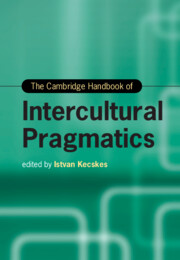Book contents
- The Cambridge Handbook of Intercultural Pragmatics
- Cambridge Handbooks in Language and Linguistics
- The Cambridge Handbook of Intercultural Pragmatics
- Copyright page
- Contents
- Figures
- Tables
- Acknowledgment
- Contributors
- Introduction The Rise of Intercultural Pragmatics
- Part I Theoretical Foundation
- Part II Key Issues in Intercultural Pragmatics Research
- Part III Interface of Intercultural Pragmatics and Related Disciplines
- 15 Semiotics and Intercultural Pragmatics
- 16 Sociopragmatics and Intercultural Interaction
- 17 Intercultural Pragmatics from the Perspective of English as a Lingua Franca
- 18 Intercultural Rhetoric
- 19 Politeness and Rapport Management
- 20 Corpus Pragmatics: Corpus-Based Intercultural Pragmatic Research
- Part IV Intercultural Pragmatics in Different Types of Communication
- Part V Language Learning
- Index
- References
17 - Intercultural Pragmatics from the Perspective of English as a Lingua Franca
from Part III - Interface of Intercultural Pragmatics and Related Disciplines
Published online by Cambridge University Press: 29 September 2022
- The Cambridge Handbook of Intercultural Pragmatics
- Cambridge Handbooks in Language and Linguistics
- The Cambridge Handbook of Intercultural Pragmatics
- Copyright page
- Contents
- Figures
- Tables
- Acknowledgment
- Contributors
- Introduction The Rise of Intercultural Pragmatics
- Part I Theoretical Foundation
- Part II Key Issues in Intercultural Pragmatics Research
- Part III Interface of Intercultural Pragmatics and Related Disciplines
- 15 Semiotics and Intercultural Pragmatics
- 16 Sociopragmatics and Intercultural Interaction
- 17 Intercultural Pragmatics from the Perspective of English as a Lingua Franca
- 18 Intercultural Rhetoric
- 19 Politeness and Rapport Management
- 20 Corpus Pragmatics: Corpus-Based Intercultural Pragmatic Research
- Part IV Intercultural Pragmatics in Different Types of Communication
- Part V Language Learning
- Index
- References
Summary
Worldwide communication in English as a Lingua Franca (ELF) is enacted between people from different linguacultural backgrounds, so it would seem self-evident that it is inter cultural in its very nature. Pragmatically, however, it is not essentially different from “monolingual” / “intracultural” communication. In both cases, participants have to bring their diverse linguistic resources and schematic preconceptions into convergence on common ground. To conceive of this diversity as relating only to different named languages and the cultures associated with them is to disregard the vast variation in linguistic resources and schematic preconceptions that obtains within so-called monolingual communities. So to describe the use of ELF as exceptionally multilingual and intercultural is to misrepresent it as a distinct way of communicating. What makes ELF distinctive, and a significant area of study, is not that it is a different kind of communication, but on the contrary, that it so clearly brings out how communication works in general: since the degree of linguistic and schematic disparity between participants is likely to increase the challenge of convergence, the pragmatic process of achieving convergence will naturally become particularly apparent.
Keywords
- Type
- Chapter
- Information
- The Cambridge Handbook of Intercultural Pragmatics , pp. 445 - 468Publisher: Cambridge University PressPrint publication year: 2022
References
- 2
- Cited by



